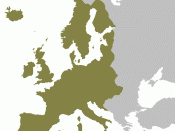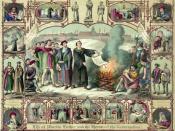By the 16th century, the Roman Catholic Church's corruption was beginning to spread. Simony, or the buying of church offices, was common along with pluralism which was the appointment of multiple bishops in multiple areas. Tithing had become mandatory to support the church's bloated clergy, yet it was the poorly paid servents who did the priest's duties. Meanwhile due to the invention of the printing press, common people were reading doctrine for themselves. All these factors sparked a major discontent with the church. With the Renaissance that proceeded and the French Revolution that followed, the Reformation completely altered the medieval way of life in Western Europe and initiated the era of modern history. Although the movement dates from the early 16th century, when Martin Luther first defied the authority of the church, the conditions that led to his revolutionary stand had existed for hundreds of years and had complex doctrinal, political, economic, and cultural elements.
A man by the name of Martin Luther became the focal point of this discontent when he published his 95 theses. One of the first issues he attacked was the selling of indulgences, or paying for one's sins in advance. He advocated that the Bible needed to translated into common languages, namely German, and he preached an emphasis on individual belief. His writing spread so well through the printing press that by the middle of the 16th century half of the German population had adopted the Lutheran religion.
In England, another reformation took place. Henry XIII's marriage to Catherine of Aragon was not producing a son, so Henry wanted a divorce. When the pope refused to grant the divorce, Henry severed all ties with him, and made himself the Supreme Head of the Anglican Church, or simply put, the pope of England.
Meanwhile, in France...

